Practical Interior Design Tips for Living Room and Bedroom
Interior design shapes how you live, move, and feel within your home. Thoughtful choices make small spaces feel larger, create calm in busy households, and highlight the personality of people who live there. This article breaks down practical advice you can use for furniture selection, home decor choices, and room layouts—especially for the living room and bedroom—so you can improve comfort, flow, and aesthetics without unnecessary complexity.

What is interior design and why it matters
Interior design blends function, safety, and beauty to create spaces that support daily life. It’s more than picking pretty colors: designers consider circulation, lighting, ergonomics, storage, and material durability. Good interior design solves problems—like awkward room shapes or poor lighting—while reflecting your taste. For a practical approach, start with a room’s primary functions, list must-have elements, and prioritize changes that improve usability. Whether you work with local services or DIY, thinking systemically keeps results cohesive and lasting.
How to choose furniture for flow and comfort
Furniture anchors a room and sets its scale, so choose pieces that match a room’s size and intended use. Measure before you buy: leave enough circulation space around sofas and beds, and ensure doorways and pathways remain unobstructed. For comfort, test seating and mattress firmness where possible. Consider multi-functional furniture—storage ottomans, sleeper sofas, or beds with drawers—for smaller homes. Pay attention to materials: durable upholstery and easy-to-clean finishes extend lifespan. A balanced mix of statement and functional pieces keeps a space visually interesting and practical.
Can home decor reflect your style sustainably?
Home decor offers low-commitment ways to express personality: rugs, cushions, art, and lighting. To keep choices sustainable, prioritize quality over trends and select items with neutral bases you can update with seasonal accents. Vintage or secondhand finds add character while reducing waste. Use textiles and plants to introduce texture and life without major renovation. When buying new, look for responsible materials and brands with transparent sourcing. Thoughtful home decor both personalizes rooms and supports longer-lasting design that adapts as your tastes evolve.
How to design an inviting living room space
A successful living room balances social zones, media needs, and relaxation. Start by defining a focal point—fireplace, TV, or a large window—and arrange seating to encourage conversation while maintaining sightlines. Layer lighting with overhead, task, and accent fixtures to adjust mood and function. Use rugs to anchor seating groups and scale furniture to the room size. Incorporate storage solutions like built-in shelving or credenzas to reduce clutter. For a cohesive look, repeat a few colors or materials throughout the living room and introduce contrasting textures to make the space feel warm and intentional.
Tips for a restful bedroom layout and color
Bedrooms benefit from a calming palette and uncluttered layout. Position the bed as the room’s anchor, ideally visible from the doorway, and allow comfortable access on both sides. Choose soothing colors—muted neutrals, soft blues, or warm earthy tones—and limit high-contrast patterns if you want a tranquil atmosphere. Prioritize blackout curtains or layered window treatments for better sleep and add bedside lighting for reading. Invest in storage solutions that keep surfaces clear: under-bed drawers, built-in closets, and bedside tables with drawers help maintain an orderly, restful environment.
A cohesive plan ties living room and bedroom choices together. Use consistent finishes—metal tones, wood stains, or upholstery textures—across rooms to create continuity. Layer in personal elements like artwork and textiles that reflect your story without overwhelming the space. When considering larger changes or hiring professionals, look for designers or installers through reputable local services and review portfolios to ensure style alignment. Small, well-chosen updates often have the biggest impact on daily comfort and long-term satisfaction.
Conclusion
Interior design is a practical tool for improving how your home supports life and rest. By focusing on function first—then adding furniture, home decor, and layered lighting—you can create living room and bedroom spaces that feel cohesive, comfortable, and true to your taste. Thoughtful planning, attention to scale, and selective investments help rooms work better and look more considered over time.






